 IST,
IST,
V. Domestic Financial Markets
Money
Market
Foreign Exchange Market
Credit
Market
Government Securities Market
Equity
Market
Financial markets were flush with liquidity generated by surges in external inflows during 2003-04. In the foreign exchange market, the rupee faced upward pressure vis-a-vis the US dollar throughout the year. Forward premia declined across the board in the second half of the year and even turned into discounts in the third quarter before firming up marginally towards the close of the year. Call rates remained stable, ruling persistently below the repo rate despite large sterilisation operations (Chart 35). Gilt yields softened during the first half of the year but remained generally range-bound in the second half as inflation edged up in January and February 2004. The yield curve flattened throughout the first half of the year, undergoing some correction from November with some firming of international interest rates and profit booking by investors.
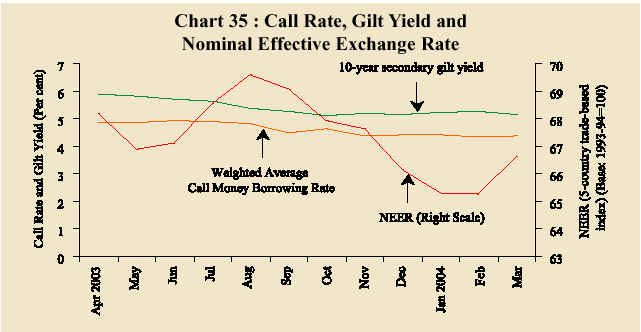
In the credit market, ample liquidity conditions and the soft interest rate bias in monetary policy enabled banks to cut deposit rates. Lending rates also declined, though they remained relatively sticky. The introduction of the benchmark prime lending rate (PLR) system brought about some moderation from the level of tenor linked PLRs of the earlier regime. Non-food credit, which had been subdued in the first half of the year, started picking up after August 2003. Credit to medium and large industry decelerated while priority sector and retail lending recorded substantial increases. The equity market revived strongly from end-May 2003 in a broad-based rally (Table 15).
Table 15: Financial Markets at a Glance - 2003-04
| Call Money | Gilt |
Foreign Exchange |
Liquidity Management |
Equity | ||||||||||
| Month |
Average |
Average |
Turnover |
Average | Average | RBI’s
net |
Forward |
Net | Average | Average |
Average |
Average |
Average |
Average |
| 1 |
2 |
3 |
4 |
5 |
6 |
7 |
8 |
9 |
10 |
11 |
12 |
13 |
14 |
15 |
| April |
17,338 |
4.87 | 2,26,803 |
5,585 |
47.38 |
1,432 |
2.08 | -7 |
27,372 |
109 | 1,041 |
2,449 |
3037 | 965 |
| May |
18,725 |
4.87 | 2,99,933 |
5,960 |
47.08 |
2,342 |
1.1 | -5,569 |
25,223 |
10 | 1,072 |
2,604 |
3033 | 963 |
| June |
20,544 |
4.91 | 3,00,504 |
5,837 |
46.71 |
896 | 2.76 |
-44 | 24,805 |
– | 1,187 |
2,933 |
3387 | 1069 |
| July |
18,698 |
4.90 | 3,04,587 |
5,920 |
46.23 |
3,146 |
2.65 | -57 |
42,690 |
39 | 1,434 |
3,429 |
3665 | 1150 |
| August |
19,556 |
4.83 | 4,09,539 |
5,983 |
45.93 |
2,352 |
2.25 | -11,546 |
39,995 |
0 | 1,817 |
4,267 |
3978 | 1261 |
| September |
20,584 |
4.50 | 2,65,848 |
6,862 |
45.85 |
2,345 |
0.91 | -5,107 |
31,373 |
0 | 2,032 |
4,698 |
4315 | 1369 |
| October |
23,998 |
4.64 | 3,89,968 |
7,672 |
45.39 |
1,593 |
0.02 | -13,986 |
13,569 |
0 | 2,288 |
5,026 |
4742 | 1506 |
| November |
15,156 |
4.38 | 1,77,063 |
6,795 |
45.52 |
3,449 |
(-) 0.002 |
-69 | 21,182 |
0 | 2,251 |
4,644 |
4951 | 1580 |
| December |
15,276 |
4.40 | 1,81,991 |
6,207 |
45.59 |
2,888 |
(-) 0.30 |
-132 | 32,020 |
0 | 2,492 |
5,017 |
5425 | 1740 |
| January |
14,189 |
4.43 | 1,81,619 |
7,306 |
45.46 |
3,294 |
.0.50 |
-5,228 |
38,539 |
0 | 3,125 |
6,394 |
5954 | 1906 |
| February |
9,809 |
4.33 | 1,39,130 |
7,171 |
45.27 |
3,357 |
0.51 | -35 |
46,244 |
0 | 2,709 |
5,722 |
5827 | 1849 |
| March |
12,422 |
4.37 | 2,22,685 |
8,018 |
45.02 |
3,382 |
0.62 | -69 |
54,915 |
0 | 2,308 |
4,767 |
5613 | 1780 |
| OMO: Open
Market Operations. + Outright turnover in Central Government dated securities. | ||||||||||||||
The average daily call money borrowing rate remained below the repo rate over the greater part of the year, except in short-lived episodes in August and October 2003 (Chart 36). The sustained pace of capital flows left money markets with abundant liquidity in spite of continuous absorptions through repo and open market operations.
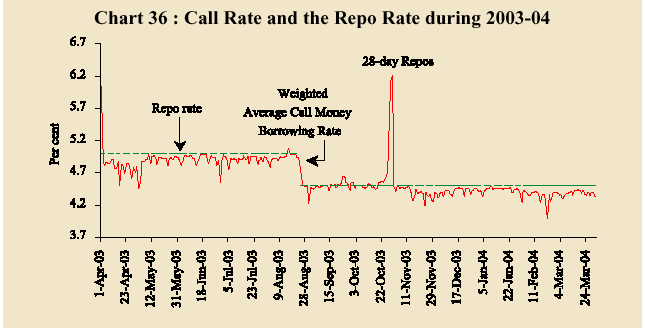
Unsterilised exchange market interventions, unwinding of the year-end tightness in liquidity and deferred government expenditure pushed the average call rate below the repo rate from April 2003. Fund outflows on account of State Government borrowings and open market sales resulted in isolated spikes in the call rate and some volatility in August related to the bomb blasts in Mumbai. The call rate adjusted smoothly to the 50 basis point repo rate cut, effective August 25, and hovered around the repo rate throughout September and early October, in spite of the redemption of the Resurgent India Bonds (Rs.22,693 crore). Measures by the Reserve Bank (28-day repos and open market operations) to absorb excess liquidity from the system in the second half of October resulted in temporary volatility in call rates. Stability returned quickly with the call rate remaining below the repo rate from November. The call rates dipped in February 2004 as large capital inflows continued and were largely unsterilised. They recovered in March to a little below the repo rate (Table 16). The call rates continued to be stable at about 4.3 per cent in a April 2004 with the average daily turnover working out to Rs. 12,916 crore.
Table 16 : Call/ Notice Money Market: 2003-04
| Month |
Average Call/Notice |
Co-efficient of |
Average Daily Call/ |
| Money Borrowing Rate | Variation of | Notice Money Turnover | |
|
(Per cent) |
Call Rate |
(Rs. crore) | |
| 1 |
2 |
3 |
4 |
| April |
4.87 | 0.07 |
17,338 |
|
May | 4.87 |
0.02 | 18,725 |
| June |
4.91 | 0.02 |
20,544 |
|
July | 4.90 |
0.01 | 18,698 |
| August |
4.83 | 0.04 |
19,556 |
|
September | 4.50 |
0.01 | 20,584 |
| October |
4.64 | 0.09 |
23,998 |
|
November | 4.38 |
0.02 | 15,156 |
| December |
4.40 | 0.01 |
15,276 |
|
January | 4.43 |
0.01 | 14,489 |
| February |
4.33 | 0.02 |
9,809 |
|
March | 4.37 |
0.01 | 12,422 |
The turnover in the call/notice money market declined during 2003-04 on account of a significant improvement in liquidity, reduction in CRR and higher placement of funds in LAF repos. There was also migration of a part of call borrowing to market repos and to the Collateralised Borrowing and Lending Operations (CLBO) segments on account of cheaper funding costs in these markets vis-à-vis the call/ notice market. With the tightening of prudential norms relating to the exposure of banks to the call market and the gradual phasing out of non-bank participants from the call market, activity in the repo market (outside the Reserve Bank) increased (Chart 37)
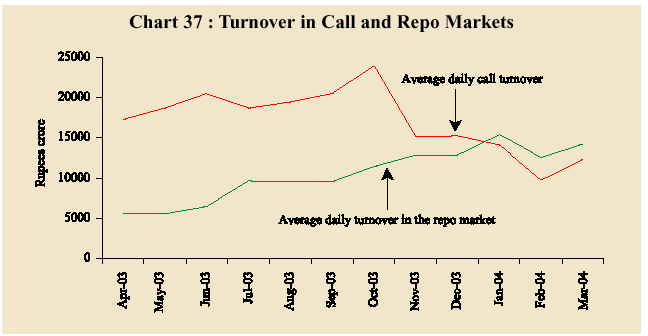
Treasury Bills
Primary yields of 91-day Treasury Bills and 364-day Treasury Bills moved synchronously with call rates, largely staying below the repo rate. Excess liquidity conditions in the beginning of the year evinced a vigorous market response to auctions with bid-cover ratios (ratio of competitive bid amount received to notified amount) crossing four for 91-day Treasury Bills and three for 364-day Treasury Bills around mid-April 2003. Yield spreads between the 91-day and 364-day instruments were virtually absent during end-May to August 2003. The notified amount of 91-day Treasury Bills was raised temporarily from Rs.500 crore to Rs.1,500 crore for eight auctions starting from August 6, 2003 to September 24, 2003, keeping in view the ample liquidity in the system. Temporary misalignment in the Treasury Bill yields was corrected when the notified amount of 91-day Treasury Bills was lowered to Rs.500 crore from October 1, 2003. Treasury Bill yields increased in January and February 2004 with edging up of inflation but softened by March as inflation fears subsided and conditions of surplus liquidity prevailed (Chart 38).
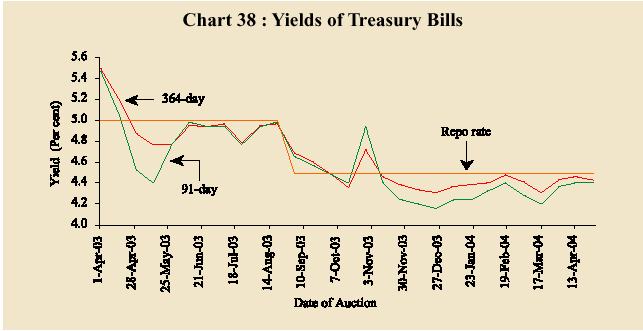
Primary yields of Treasury Bills moved downward during 2003-04, but hardened marginally during February 2004, primarily on account of market uncertainty relating to the issue of securities under the market stabilisation scheme. Yields, however, fell back in March reflecting a large liquidity overhang in the system. Yields hardened again with the spread between 91-day and 364-day yields around three basis points on April 28, 2004 The bid-cover ratio indicated responsible participation in the auctions (Table 17).
Table 17 : Treasury Bills in the Primary Market: 2003-04
| Average Implicit Yield at minimum | Bid-Cover Ratio | |||
|
cut-off Price (Per cent) | ||||
| 91-day |
364-day |
91-day |
364-day | |
| 1 |
2 |
3 |
4 |
5 |
| April |
5.04 | 5.19 |
4.13 | 2.56 |
| May |
4.56 | 4.77 |
1.94 | 1.88 |
| June |
4.95 | 4.95 |
1.91 | 2.51 |
| July |
4.87 | 4.88 |
3.06 | 2.15 |
| August |
4.90 | 4.96 |
1.73 | 2.01 |
| September |
4.60 | 4.65 |
2.91 | 3.32 |
| October |
4.61 | 4.53 |
2.24 | 2.38 |
| November |
4.37 | 4.42 |
3.23 | 2.32 |
| December |
4.19 | 4.32 |
2.76 | 1.80 |
| January |
4.25 | 4.37 |
2.01 | 1.98 |
| February |
4.38 | 4.44 |
3.07 | 1.72 |
| March |
4.24 | 4.36 |
3.42 | 2.28 |
Other Money Market Instruments
Comfortable liquidity conditions enabled companies to raise a higher volume of funds through the issue of commercial paper (CPs) during 2003-04. The outstanding amount of CPs increased from Rs.5,839 crore at the beginning of the year to Rs.7,646 crore by end-August 2003 before entering a period of slack through September 2003 and October 2003. Activity picked up in the CP market from December 2003 reflecting interest from mutual funds on account of the Securities and Exchange Board of India's (SEBI) guidelines on investments in non-SLR debt securities and market perception about cost effectiveness in issuances of CP vis-à-vis bonds and fixed deposits. Furthermore, reduction in stamp duty on CP issuances boosted this market. There was a decline in the amount of CPs outstanding during February and March 2004. As on April 15, 2004 the amount of outstanding CPs was Rs.9,590 crore. With the softening of interest rates across the money market, the weighted average discount rate (WADR) of prime rated companies declined by 112 basis points during 2003-04 while that of medium rated companies declined by 129 basis points (Chart 39).
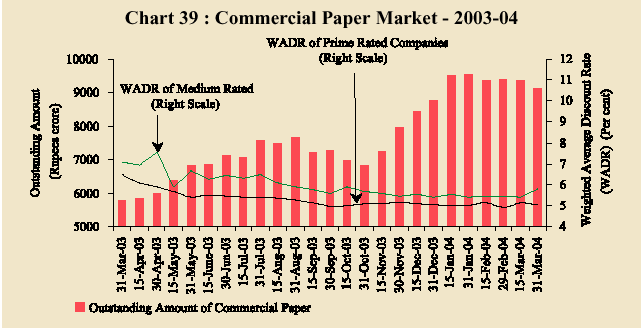
The outstanding amount of certificates of deposit (CDs) increased from Rs.1,188 crore in early April 2003 to Rs.4,831 crore by early-March 2004 mainly on account of issuances by some banks with low deposit bases (Chart 40).
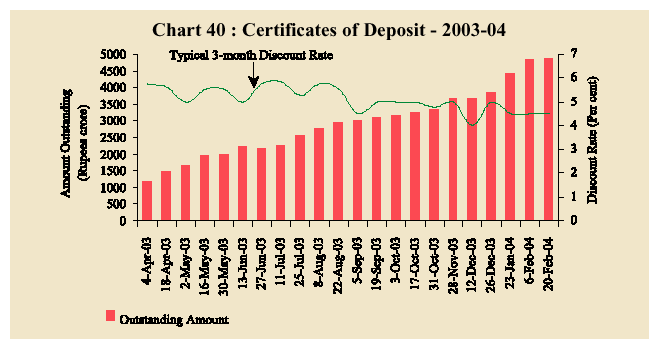
The rest of the money market segments also witnessed increased activity. The market for forward rate agreements and interest rate swaps (FRA/IRS) experienced a sharp expansion during the year with the outstanding amount increasing by about 112 per cent to Rs.5,18,260 crore. The Collateralised Borrowing and Lending Obligation (CBLO), a money market instrument operationalised through the Clearing Corporation of Indian Limited (CCIL) since January 20, 2003, recorded an increase in average daily turnover from Rs.47 crore in April 2003 to Rs. 2,506 crore in March 2004. This market is expected to see further growth with real-time connectivity between the Public Debt Office of the Reserve Bank and CCIL in place and value-free transfer of securities operationalised for CBLO.
Foreign Exchange Market
The foreign exchange market was characterised by persistent conditions of excess supply during 2003-04 on account of sustained foreign exchange inflows. In spite of rising demand for imports and large outflows in the capital account due to debt repayments, the Indian rupee appreciated by 9.3 per cent against the US dollar during the year. The rupee, however, weakened against other major currencies. Accordingly, the five-country trade-weight based nominal effective exchange rate (NEER) remained broadly stable at the March 2003 level (Chart 41). Uncertain market sentiments were reflected in intra-week volatility in April 2004 despite ample supply conditions. The rupee depreciated by 2.1 per cent against the US dollar but appreciated by 0.7 per cent against the euro and 3.4 per cent against the yen during the month.
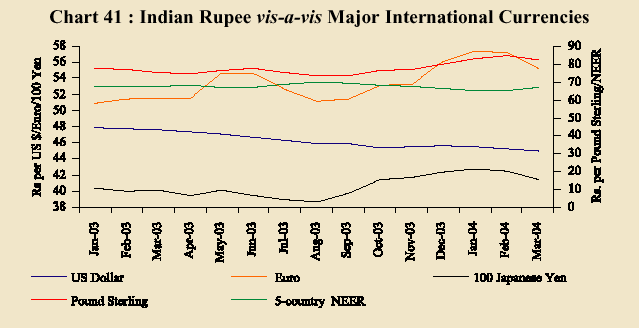
Activity in both the merchant and inter-bank segment of the foreign exchange market increased strongly. While the merchant turnover increased from US $ 25 billion in April 2003 to US $ 56.6 billion in March 2004, the inter-bank turnover increased from US $ 89.4 billion to US $ 168.4 billion during the same period (Chart 42). The ratio of inter-bank to merchant turnover hovered in the range of 3-4, indicating normal hedging activity and stability in exchange rate expectations.
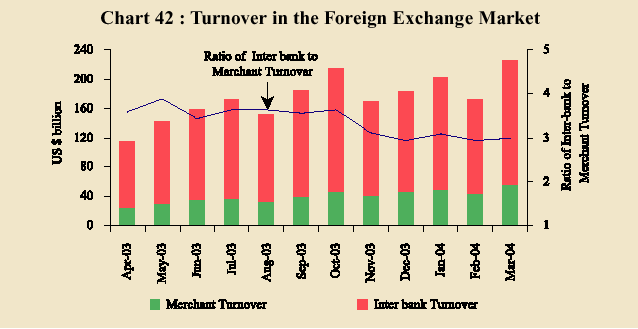
The rupee's upward drift against the US dollar in the spot exchange market drove banks, exporters and corporates to book heavy forward US dollar sales. As a result, forward premia declined sharply over the year turning into discounts on the US dollar during the period October-December 2003. Forward premia turned positive in January and February 2004 with the gradual easing of pressure in the cash market. In March forward premia were generally below one per cent across the maturity spectrum as against a range of 3.5-3.8 per cent during March 2003. Large capital inflows pushed down the forward premia again into slender discounts of around one per cent in April 2004 (Chart 43).
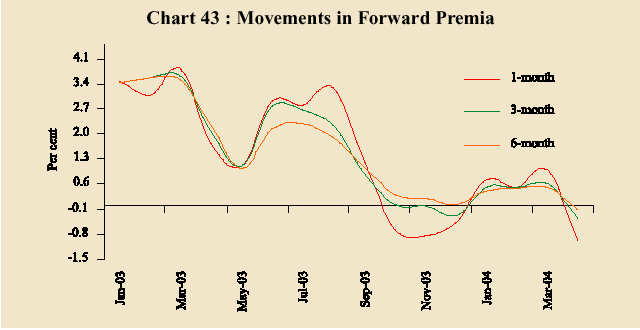
Credit Market
In view of easy liquidity conditions and lower market interest rates, public sector banks (PSBs) reduced deposit rates in the one-year and above tenor from a range of 5.25-7.00 per cent in March 2003 to 5.00-5.75 per cent by April 16, 2004 (Table 18). Deposit rates of the private and foreign banks also eased but the decline in banks' prime lending rate (PLR) was relatively muted.
Table 18 : Deposit and Lending Rates
| (Per cent) | ||||||
| March |
June |
September |
December |
March | ||
|
2003 |
2003 |
2003 |
2003 |
2004# | ||
|
1 | 2 |
3 |
4 |
5 |
6 | |
| 1. |
Domestic Deposit Rate | |||||
| Public Sector Banks | ||||||
| Up to 1 Year | 4.00-6.00 |
4.00-5.75 |
3.75-5.50 |
3.75-5.25 |
3.75-5.25 | |
|
>1-3 Years | 5.25-6.75 |
5.00-6.25 |
4.75-6.00 |
5.00-5.75 |
5.00-5.75 | |
|
>3 Years | 5.50-7.00 |
5.25-6.50 |
5.25-6.25 |
5.25-6.00 |
5.25-6.00 | |
|
Private Sector banks | ||||||
| Up to 1 Year | 3.50-7.50 |
3.00-7.00 |
3.00-7.00 |
3.00-6.25 |
3.00-6.00 | |
|
>1-3 Years | 6.00-8.00 |
5.50-7.75 |
5.50-7.50 |
5.00-7.00 |
5.00-6.50 | |
|
>3 Years | 6.00-8.00 |
6.00-8.00 |
5.75-8.00 |
5.50-7.00 |
5.25-7.00 | |
|
Foreign banks | ||||||
| Up to 1 Year | 3.00-7.75 |
3.00-7.75 |
3.00-7.75 |
2.75-7.75 |
2.75-7.75 | |
|
>1-3 Years | 4.15-8.00 |
3.50-8.00 |
3.50-8.00 |
3.35-8.00 |
3.30-8.00 | |
|
>3 Years | 5.00-9.00 |
4.50-8.00 |
3.75-8.00 |
3.50-8.00 |
3.25 – 8.00 | |
|
2. | Prime Lending Rate# | |||||
| Public sector Banks | 9.00-12.25 |
9.00-12.25 |
9.00-12.25 |
9.00-12.25 |
10.25-11.50 | |
|
Private Sector Banks |
7.00-15.50 | 7.00-15.50 |
8.00-15.50 |
7.50-15.50 |
10.50-13.00 | |
|
Foreign Banks | 6.75-17.50 |
5.45-17.50 |
4.80-17.50 |
4.55-17.50 |
11.00-14.85 | |
|
3. | Actual Lending Rates* | |||||
| Public sector Banks | 6.00-16.25 |
5.00-16.00 |
5.75-16.00 |
5.75-16.00 |
NA | |
|
Private Sector Banks |
5.18-23.00 |
4.95-23.00 |
3.00-23.00 |
3.00-23.00 |
NA | |
|
Foreign Banks | 5.40-20.00 |
5.00-23.00 |
5.00-22.00 |
3.00-22.00 |
NA | |
| *Interest rate on non-export demand and term loans above Rs.2 lakh excluding lending rates at the extreme 5 per cent on both sides. #Benchmark PLR/ PLR for March 2004. | ||||||
Sub-PLR lending of the banking system (excluding exports, the bulk of which is at sub-PLR) constituted about half of the total outstanding advances above Rs.2 lakh. The spreads around PLRs of PSBs for term loans (excluding 5 per cent of the credit sanctioned at extreme rates on either side of lending) narrowed marginally during September-December 2003.
During the period March 2003 and March 2004, the range of benchmark PLRs (BPLR) at their upper limits was moderated by 75-265 basis points from the existing PLRs, partly as a result of the introduction of the benchmark concept. As per the information available, nearly all banks have adopted BPLRs on April 1, 2004 by abandoning the system of tenor linked PLR. During January to March 2004, the range of BPLRs was 10.25-14.85 per cent. The level of BPLRs continued unchanged in April 2004.
Food credit extended by the banking system declined in consonance with lower procurement. Non-food credit picked up in the second half of 2003-04, driven up by credit to the priority sector, retail credit and export credit. The main driver of credit within the priority sector were ‘other priority sectors’ and agricultural credit. Credit to housing picked up in 2003-04 primarily on account of policy incentives and lower interest rates. Credit to medium and large industry and wholesale trade recorded lower growth (Table 19).
Table 19 : Deployment of Bank Credit
| (Rupees crore) | |||||
| Sector/Industry |
Variations | ||||
| 2002-03 |
2003-04 | ||||
| Up to February | Up to February | ||||
|
Absolute |
Per cent |
Absolute |
Per cent | ||
|
1 |
2 |
3 |
4 |
5 | |
| 1 |
Priority sector# | 19,548 |
11.2 | 39,076 |
18.5 |
|
Agriculture | 7,424 |
12.2 | 11,001 |
15.0 | |
|
Small Scale | 2,119 |
3.7 | 3,500 |
5.8 | |
|
Others | 10,005 |
17.5 | 24,575 |
31.6 | |
|
2 | Industry (Medium and Large) | 22,070 |
12.8 | 6,807 |
2.9 |
|
Iron and Steel | 1,479 |
7.4 | -1,896 |
-6.8 | |
|
Electricity | 1,008 |
10.8 | 2,057 |
18.4 | |
|
Cotton Textiles | 2,072 |
17.6 | 1,040 |
6.6 | |
|
Chemicals, Dye, Paints |
839 | 3.2 |
-1,175 |
-3.7 | |
|
Gems and Jewellery | 1,219 |
18.9 | 1,378 |
18.3 | |
|
Petroleum | -1,331 |
-11.8 |
-1,648 |
-11.2 | |
|
Infrastructure | 5,466 |
36.9 | 8,731 |
33.2 | |
|
3 | Housing |
9,974 |
44.6 | 14,774 |
40.4 |
|
4 | Non-Banking Financial Companies | 2,914 |
30.2 | 625 |
4.4 |
|
5 | Wholesale Trade | 2,192 |
10.7 | 1,132 |
5.0 |
|
6 | Export Credit | 3,710 |
8.6 | 6,236 |
12.7 |
| # Excluding investments in eligible securities. Note: Data are provisional and
relate to select scheduled commercial banks which account for about | |||||
Petroleum, chemicals and iron and steel industries recorded a decline in bank credit demand. On the other hand, gems and jewellery and infrastructure recorded a healthy growth in credit off-take (Chart 44). The decline in overall credit to industry during April 2003 to February 2004 can be attributed, inter alia, to an increased recourse by corporates to internal sources of financing enabled by higher profits as well as surge in debt issues in the private placement market and higher external commercial borrowings.
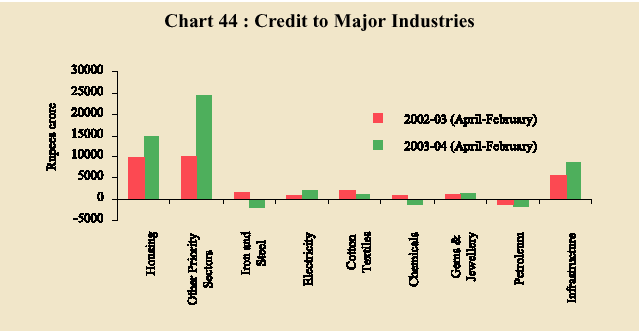
Operational and prudential indicators for the banking system point to a growing resilience. Commercial bank profitability continued to increase during 2003-04. Both gross NPA to gross advances and net NPA to net advances ratios were lower during the first half of 2003-04 than in the corresponding period of 2002-03 (Table 20). By end-September 2003, banks had recovered Rs. 769 crore from 13,583 cases out of an aggregate amount outstanding of Rs.14,141 crore in 42,047 cases.
Table 20 : Important Parameters of Scheduled Commercial Banks
|
(per cent) | |||
| Parameter |
March 2003 |
April-September # | |
| 2003-04 |
2002-03 | ||
|
1 | 2 |
3 |
4 |
| Operating Expenses/Total Assets |
2.2 | 1.1 |
1.1 |
|
Spread/Total Assets |
2.8 | 1.5 |
1.5 |
|
Net Profits/Total Assets |
1.0 | 0.6 |
0.5 |
|
Gross Non-Performing Assets to Gross Advances |
8.8 | 9.7 |
11.1 |
|
Net Non-Performing Assets to Net Advances |
4.4 | 4.0 |
5.5 |
|
CRAR | 12.6 |
13.2 | 12.5 |
| #Data relate to domestic operations only. | |||
Government Securities Market
Average monthly volumes of secondary market transactions in Government securities through the subsidiary general ledger (SGL) increased sharply to Rs.2,19,991 crore during 2003-04 as against Rs.1,61,804 crore during 2002-03. Ample liquidity conditions enabled reduction in yields in the Government securities market during the first half of 2003-04. As non-food credit off-take began to recover, market sentiment limited the softening of the yields during the second half of the year (Chart 45).
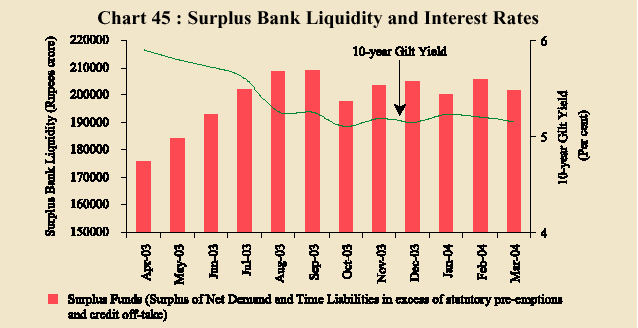
Liquidity conditions facilitated a smooth completion of the borrowing programme of the Central Government, which was truncated by a persistent cash surplus in its current account since August 8, 2003. The weighted average cost of market borrowing through issuances of dated securities declined to 5.74 per cent during 2003-04 from 7.34 per cent in 2002-03. The weighted average maturity increased to 14.94 years from 13.83 years. The first ever buy-back auction through an interactive platform developed by CCIL enabled the market to return 19 high coupon but relatively illiquid Government securities amounting to a total face value of Rs.14,434 crore in exchange for four liquid securities involving a buy back premium of Rs.3,472 crore paid by the Government. There were three issuances of Floating Rate Bonds aggregating Rs.16,000 crore.
The yield curve flattened in the secondary market for Government securities during the first half of 2003-04. Despite intermittent price rallies under easy liquidity conditions, gains were capped as the market borrowing programme of the Government intensified and open market sales were conducted. The repo rate reduction, effective August 25, 2003, boosted market sentiment with the 10-year yield declining to 5.23 per cent on August 26, 2003. The announcement of the calendar of issuance of Government securities for the second half of 2003-04 was much lower than the anticipated amount. Market sentiment lifted, leading to a fall in yields across short to medium-tenor securities at the end of the second quarter of 2003-04 (Chart 46).
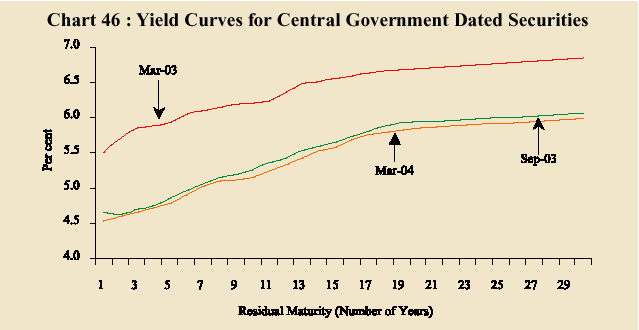
In the second half of 2003-04, inflation expectations hardened at the long end of the maturity spectrum. The lowering of cut-off yields on 364-day Treasury Bills drove down the 10-year yield on Government securities to a low of 4.95 per cent on October 16, 2003. Open Market Operation (OMO) sales and a series of 28-day repos under the LAF in the second fortnight of October checked possible rallies. As portfolio switches occurred, the outright transactions in Central Government securities, which had moved up from Rs.1,13,402 crore in April 2003 to Rs.1,94,984 crore in August 2003, decreased to Rs.90,810 crore in January 2004. With liquidity at high levels, yields inched down in March 2004. During the year, the 10-year yield declined by 106 basis points from 6.21 per cent at the end of March 2003 to 5.15 per cent at the end of March 2004. Yields moved up for securities of tenor of 14 year and above by around 13 basis points on an average and by seven basis points for tenors between four year and 10 year. The larger than expected drop in inflation boosted demand for securities at the longer end causing the yield curve to flatten in March 2004. Yield spreads between Government securities and AAA-rated corporate bonds widened marginally during the latter half of the year (Chart 47).
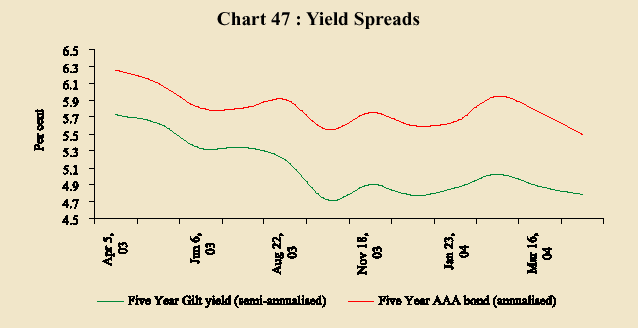
The Government securities market remained bullish in April 2004 amidst ample liquidity conditions with the 10-year yield hovering around 5.14 per cent at the end of the month. The yield curve flattened as the supply of securities increased at the short end while excess demand prevailed at the long end.
Equity Market
The stock markets broke out of the subdued conditions prevailing since February 2000 in a sustained upturn from the end of May 2003. The BSE Sensex crossed the 6100 mark in January 2004 in a strong rally (Chart 48). The BSE Sensex had crossed the 6000 mark only once before in intra-day trading during February 2000. Intermittent bouts of correction occured since February 2004. Notwithstanding the correction on profit booking at higher levels, the underlying macroeconomic fundamentals continued to be strong. The average BSE-Sensex during April 2004 worked out to 5809.
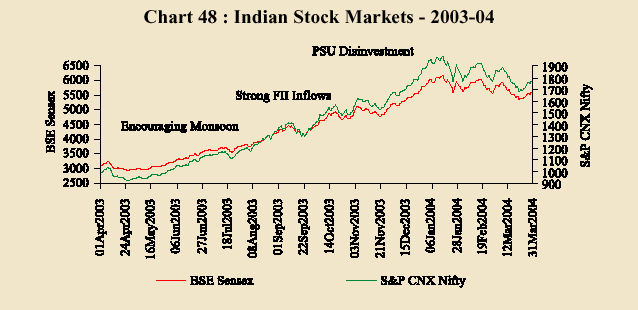
The increase in stock prices was accompanied by a rise in market capitalisation, turnover and volatility (Table 21).
Table 21: Stock Market Indicators
|
2003-04 |
2002-03 |
2003-04 |
2002-03 | |
|
1 | 2 |
3 |
4 |
5 |
| Average BSE Sensex/ S&P CNX Nifty | 4492.19 |
3206.29 |
1427.50 |
1037.23 |
|
Volatility (Coefficient of Variation) (Per cent) |
22.95 |
4.85 | 23.30 |
5.17 |
|
Turnover (Rupees crore) |
5,02,618 |
3,14,073 |
10,99,535 |
6,17,988 |
|
Market Capitalisation (end-period) (Rupees crore) |
12,01,207 |
5,72,197 |
11,20,976 |
5,37,133 |
| Source: The Stock Exchange, Mumbai (BSE) and National Stock Exchange (NSE). | ||||
The rally in 2003-04 was stronger and more broad-based than in 1999-2000. It was supported by an improvement in underlying fundamentals, strong corporate performance, a robust appetite of Foreign Institutional Investors (FIIs) for Indian equity and debt instruments as well as sector-specific factors. The revival of the stock market in India was coincident with a return of buoyancy to equity markets worldwide (Chart 49).
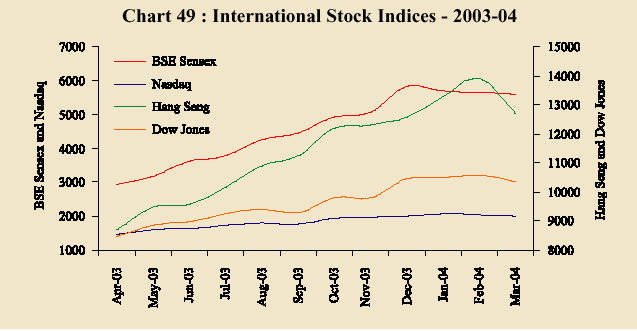
Foreign Institutional Investors (FIIs) made net investments in equity amounting to Rs.39,959 crore during 2003-04 as compared with Rs.2,528 crore during 2002-03 (Chart 50). Notably, mutual funds made net investments in equity amounting to Rs.1,308 crore during 2003-04 as compared with net sales of Rs.2,067 crore in 2002-03.
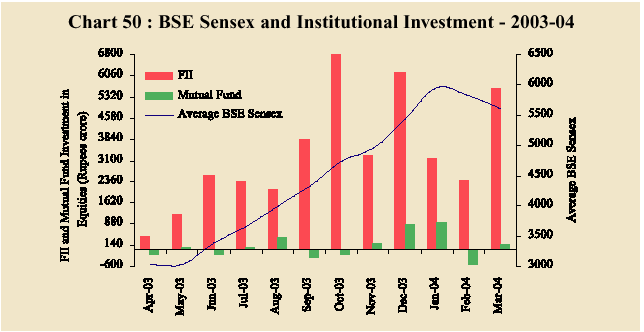
The rally in the stock market was broad-based with the BSE 500 index registering an increase of 109.4 per cent during 2003-04 as against a decline of 8.0 per cent during the preceeding year. Technology, banking, fast moving consumer goods (FMCG) stocks contributed to the rally (Chart 51).
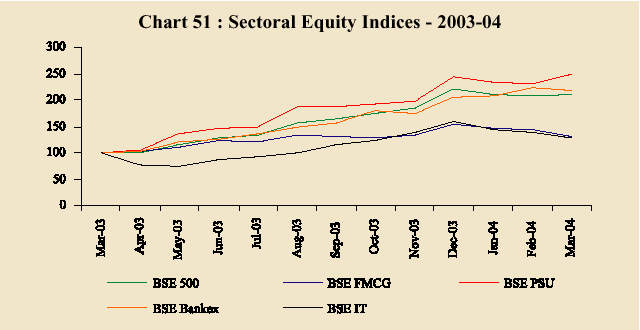
The derivative segment continued to expand with the total turnover on the NSE derivatives segment rising nearly five-fold to Rs.21,30,612 crore during 2003-04 from Rs.4,39,863 crore during 2002-03. The cash segment turnover recorded an increase, but this was modest in comparison with the derivatives market (Chart 52). In addition to stock futures and options and index futures and options, interest rate futures were introduced on the NSE, effective June 2003.
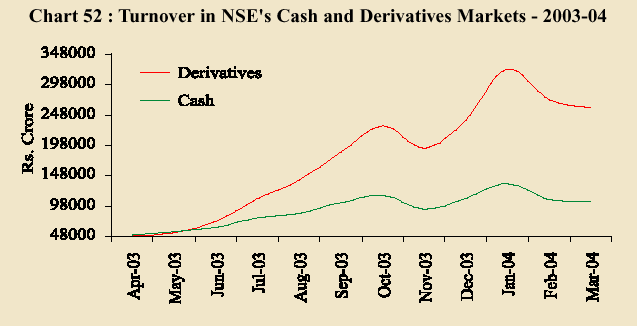
Primary Market
After a long period of lacklustre activity, the public issues market experienced a revival. Resource mobilisation in the public issues market (excluding offers for sale) amounted to Rs.7,190 crore through 35 issues during 2003-04, as against only Rs.4,867 crore raised through 17 issues during 2002-03 (Chart 53). Out of the issues floated in 2003-04, 28 were equity issues accounting for 40.5 per cent of resource mobilisation. Public sector entities accounted for 55.4 per cent of total resources mobilised in the primary market.
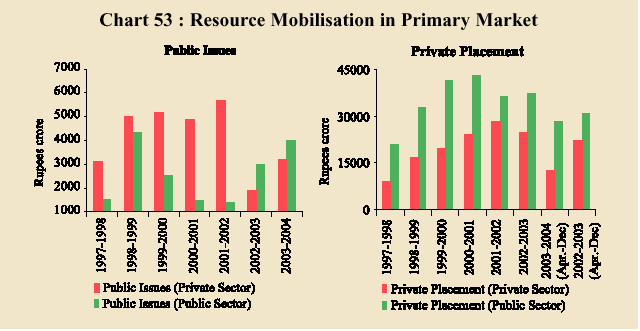
Non-Government public limited companies (private sector) garnered Rs.3,210 crore through 27 issues during 2003-04 as compared with Rs.1,878 crore raised through nine issues during the previous year. In 2003-04, 24 equity issues aggregated to Rs.1,959 crore as compared with five equity issues aggregating Rs.460 crore during the previous year. Equity issances surged during the second half of 2003-04 (Chart 54). There were three debt issues of Rs.1,251 crore (all from ICICI Bank) during 2003-04 as compared with four bond issues of Rs.1,418 crore during 2002-03.
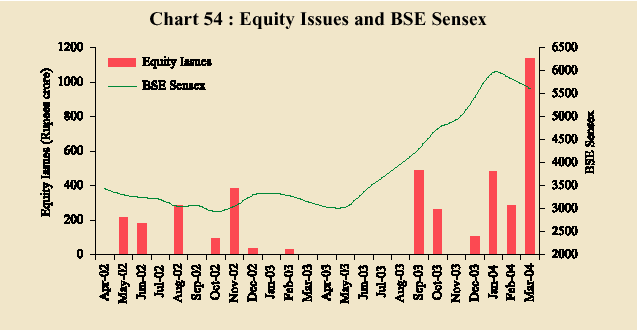
Public sector entities mobilised Rs.3,980 crore through eight issues during 2003-04 as compared with Rs.2,989 crore raised through eight issues during the previous year. Four public sector banks floated equity issues aggregating Rs.950 crore during 2003-04. All-India Financial Institutions floated three bond issues of Rs.2,930 crore (all from IDBI) during 2003-04 as compared with five bond issues aggregating Rs.2,216 crore during the previous year (Chart 55).
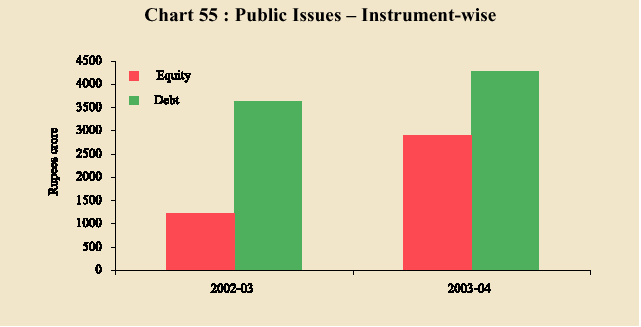
Resource mobilisation through private placement aggregated Rs.41,070 crore during April-December 2003, down from Rs.53,308 crore mobilised during the corresponding period of the previous year (see Chart 53). 131 entities entered the market in 2003-04 with 669 floatations as compared with 148 entities with 912 floatations during the corresponding period of the preceeding year. All the issues in the private placement market were debt issues excepting one equity issue. The public sector entities (mainly financial intermediaries) dominated the private placement market; however, resource mobilisation by these entities decreased marginally to Rs.28,372 crore. Public sector entities accounted for 69.0 per cent of total resource mobilisation in the private placement market as compared with 58.2 per cent in the corresponding period of the previous year.
A total of eighteen issues aggregating Rs.3,098 crore (US$ 666 million) were floated in the Euro issues market during 2003-04 as compared with eleven issues aggregating Rs.3,426 crore (US$ 711 million) during the previous year. GDR issuances recorded a sharp decline.
The resource mobilisation by mutual funds (net of redemptions) amounted to Rs.46,808 crore during 2003-04, a sharp increase of 1015.5 per cent over the preceding year. UTI recorded a net inflow of Rs.1,667 crore during 2003-04 as compared with a net outflow of Rs.9,434 crore during the previous year. The resources mobilised by private sector mutual funds increased to Rs.42,545 crore (Rs.12,069 crore in 2002-03). Public sector mutual funds mobilised Rs.2,597 crore (Rs.1,561 crore in 2002-03).
Financial assistance sanctioned and disbursed by All-India Financial Institutions increased sharply during 2003-04 to Rs.52,924 crore and Rs.31,457 crore, respectively, after a gap of more than two years.


















